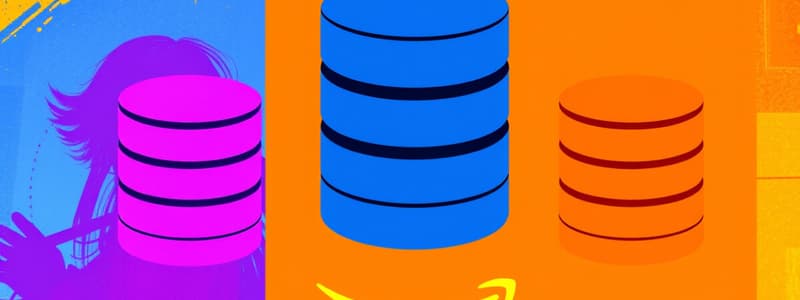Podcast
Questions and Answers
What is Amazon RDS?
What is Amazon RDS?
RDS is a managed service that makes it easy to set up, operate, and scale a relational database in the cloud.
Which relational database engines does RDS support?
Which relational database engines does RDS support?
Amazon Aurora, MySQL, MariaDB, Oracle, SQL Server, and PostgreSQL
What does RDS manage on my behalf?
What does RDS manage on my behalf?
Provisioning infrastructure capacity, installing database software, performing backups, and patching the software.
When would I use RDS vs. EC2 Relational Database AMIs?
When would I use RDS vs. EC2 Relational Database AMIs?
What is a database instance (DB instance)?
What is a database instance (DB instance)?
How many DB instances can I run with RDS?
How many DB instances can I run with RDS?
How many databases or schemas can I run with a DB instance?
How many databases or schemas can I run with a DB instance?
How do I import data into an RDS DB instance?
How do I import data into an RDS DB instance?
What is a maintenance window, and will my DB instance be available during maintenance events?
What is a maintenance window, and will my DB instance be available during maintenance events?
What should I do if my queries seem to be running slow?
What should I do if my queries seem to be running slow?
How do I control if and when the engine version of my DB instance is upgraded?
How do I control if and when the engine version of my DB instance is upgraded?
Flashcards are hidden until you start studying
Study Notes
Amazon RDS Overview
- Amazon RDS (Relational Database Service) simplifies setting up and managing relational databases in the cloud.
- Offers cost-efficient and scalable capacity while handling database administration tasks.
- Free's up users to concentrate on their applications and business needs.
Supported Database Engines
- RDS supports several relational database engines:
- Amazon Aurora
- MySQL
- MariaDB
- Oracle
- SQL Server
- PostgreSQL
Management Responsibilities of RDS
- RDS manages:
- Infrastructure provisioning
- Database software installation
- Backup operations
- Software patching
- In Multi-AZ configurations, RDS handles data replication and automatic failover.
- Users maintain control over application-specific settings, schema design, and performance tuning.
RDS vs. EC2 Relational Database AMIs
- RDS is a managed service reducing the overhead of database administration tasks.
- EC2 can run relational database AMIs providing full control, ideal for custom configurations or specific use cases.
- Choice depends on requirements for administration and management.
Database Instance (DB Instance)
- A DB instance is a dedicated database environment with designated compute and storage resources.
- Users can create/delete DB instances and manage configurations via the console, API, or CLI.
- Each DB instance can host multiple databases or schemas, determined by the chosen engine type.
DB Instance Limits
- Default limit is 40 DB instances per customer:
- Maximum of 10 instances can be Oracle or SQL under the "License Included" model.
- All instances can be Oracle or SQL under a "BYOL" (Bring Your Own License) model.
- Limit increases can be requested.
Databases and Schemas per DB Instance
- No software-imposed limits for Aurora, MySQL, MariaDB, PostgreSQL.
- Oracle allows one database per instance; no limit on schemas.
- SQL Server permits 30 databases per instance.
Importing Data into RDS DB Instance
- Data import methods vary by database:
- MySQL:
mysqldumpormysqlimport - Oracle: Data Pump, import/export, SQL Loader
- SQL Server: Import/Export wizard,
.bakfiles, Bulk Copy Program (BCP)
- MySQL:
Maintenance Windows and Availability
- Maintenance windows last 30 minutes, timing can be adjusted by users.
- Most maintenance tasks do not require downtime, only scale compute operations may briefly take the instance offline.
- Security and durability-related patching occurs infrequently with no outage in Multi-AZ deployments.
Addressing Slow Queries
- Enable Enhanced Monitoring for detailed metrics on CPU, memory, file systems, and disk I/O.
- High CPU utilization may hinder query performance; consider scaling instance class if needed.
- Access slow query logs for optimization insights (available for RDS for MySQL, MariaDB, Oracle, and SQL Server).
Engine Version Upgrades
- Manual upgrades to the latest minor version can be conducted via console or API.
- Option to enable Auto Minor Version Upgrade for automatic updates.
- Scheduled engine upgrades communicated 30 days in advance; downtime is required.
- Major upgrades do not occur automatically and may require user intervention.
Studying That Suits You
Use AI to generate personalized quizzes and flashcards to suit your learning preferences.




